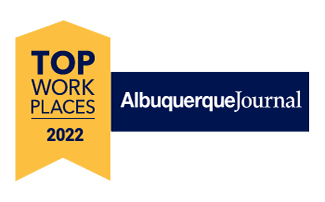
NMSBVI Resources.
Innovations | O&M Inventory | Handle With Care | Babies Count | Other Resources | Student Instruction Pages | Student & Staff Blogs
Innovations
At the heart of good education is innovation. In our efforts to meet the needs of blind & visually impaired students, NMSBVI staff have developed some new tools. We're very proud to share a few of our innovations with you... and hope that you will find them useful in your efforts to make education an exciting process for your own students.
(SC)2:
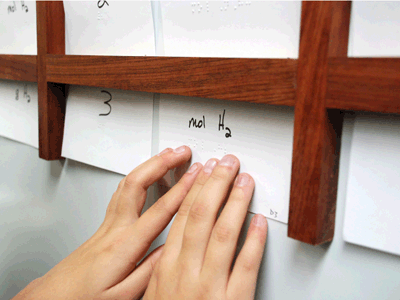
The System for Conceptualizing Spatial Concepts or, (SC)2, is an instructional tool developed within my chemistry classes at the New Mexico School for the Blind. By utilizing a system of beveled and magnetized blocks affixed to a magnetic white board, (SC)2 allows students with visual impairments to spatially arrange, manipulate, and calculate complex mathematical and scientific formulae by simply inserting 3 x 5 cards that students have brailled with values and labels of each term. It provides individuals with visual impairments equal access and participation in the classroom while encouraging higher order thinking and greater scientific and mathematical literacy for blind students.
Watch an Interview with Jeff Killebrew discussing (SC)2
Touch Grids:
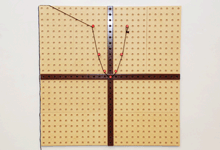
Touch Grids is an instructional tool developed within the physics classes at the New Mexico School for the Blind and Visually Impaired. Touch Grids facilitate greater mathematic and graphical literacy through the conceptualization of many graphical processes that utilize quantitative data by using a series of connectable and interchangeable grid panels, axes, and pegs. Possessing universal design features, this educational tool allows students with visual impairments the ability to bypass their visual deficiencies and gain greater independence, success, and ultimately access to advanced study or employment in STEM fields (acronym for Science, Technology, Engineering and Mathematics).
The 'Shroom:
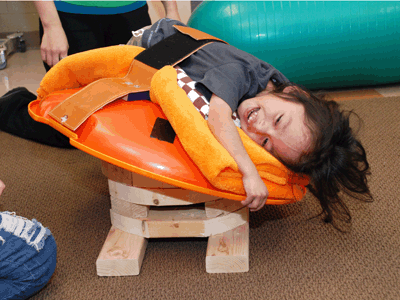
The ‘Shroom is a device on which a student can translate subtle movements, like a shift in weight or head turn, into a much more dramatic movement. The ‘Shroom, in essence, is a super sized wobble board onto which the entirety of the student’s body is placed. The movements of the student cause the ‘Shroom to dip in any number of angles and even rotate.
Tall(er) Room:
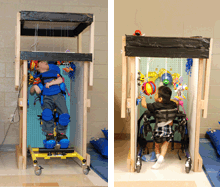
The Tall(er) Room is an offshoot of the Little Room. Some students, due to health reasons (primarily congestion and swallow issues), can’t spend extended periods of time supine on the floor or a resonance board. Others don’t have the same range of motion when on the floor that they do when supported in a chair. Still others would benefit from standing (either in a stander or gait trainer) while hand/arm motions are encouraged. Unlike a fixed height Little Room (either the standard height or one with 4’ vertical posts), the Tall(er) Room allows the teacher to raise or lower the roof to meet student need. It is tall and can get taller.
Instability Board:

The Instability Board is a simple device designed to help students with multiple impairments begin to roll over without the physical assistance of others. A student is placed on the board either in the prone or supine positions. The board is set in ‘neutral’, so that movement by the student to the left or right causes the board to tip to that side. The student is then rolled off of the board and onto the floor, the surface of which is covered by a pad, mat or blanket.
DIMC (Drive In Media Center):
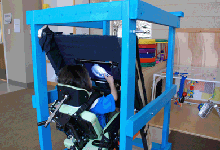
The DIMC (Drive In Media Center) was designed to allow students with positional issues to access a variety of media options. Computer screens, for example, are generally presented upright & perpendicular to the surface on which they are placed. While screens can often be tilted a few degrees the possible angles traditionally available don’t meet the needs of all students. It became clear that the solution was to allow for a far greater range of viewing angles. The DIMC was designed to allow a screen to be presented at several different angles along a 90 degree arc from perpendicular to the floor all the way to parallel to the floor.
Winter/Summer Sun Position Model:
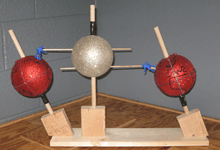
O&Ms often use the position of the sun as an integral part of cardinal directions. The sun rises in the east, is overhead around noon and sets in the west. Unless it’s winter at American/European latitudes.…then the sun rises kind of in the southeast, is off to the south around noon and sets in the southwest. The Winter/Summer Sun Position Model is a quick and easy visual and tactual way of showing students why the sun appears to be in different places in the winter and summer. As an added bonus, science teachers can use it in conjunction with other solar models and social studies teachers may find it helpful for explaining latitude and longitude.
T-Car:
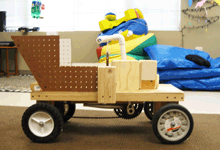
Students with multiple impairments sometimes are unable to control and move each of their four limbs. This tends to lead to limitations regarding independent mobility. A student with cerebral palsy, for example, might not ever have the ability to walk. Such students tend to be wheelchair bound. Standard wheelchairs, with rims that allow for the operator to control the wheelchair, at times can’t be controlled by the student due to limitations to range of motion in the upper extremities. The T-Car, so named due to the T shaped control handle, was devised to give students with limited control over their limbs the opportunity to get from Point A to Point B under their own steam.
Modified Power-Switch Cars:
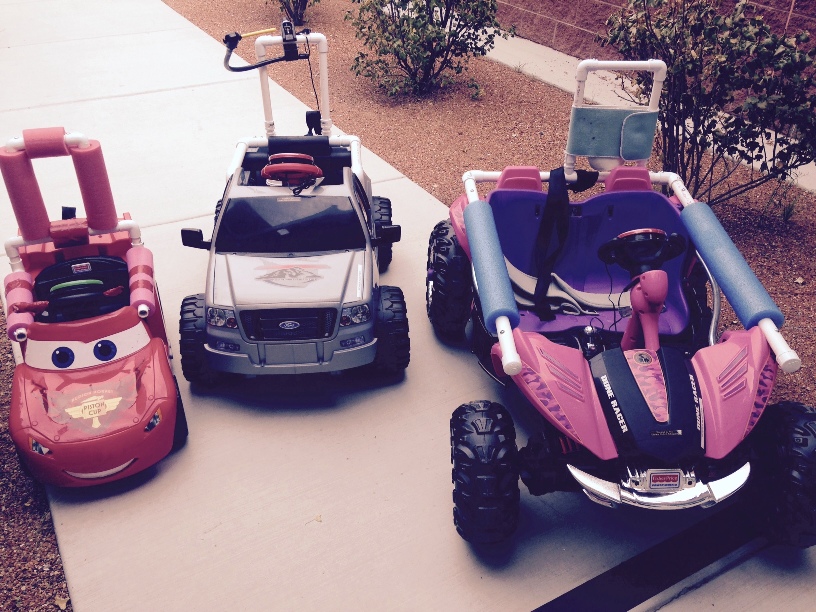
This is a photo of our three power cars at ECP; they have been adapted so that students can drive them with simple on/off jumbo switches, a joystick or a head switch.
Watch video of students using modified power-switch car
Activity Board:
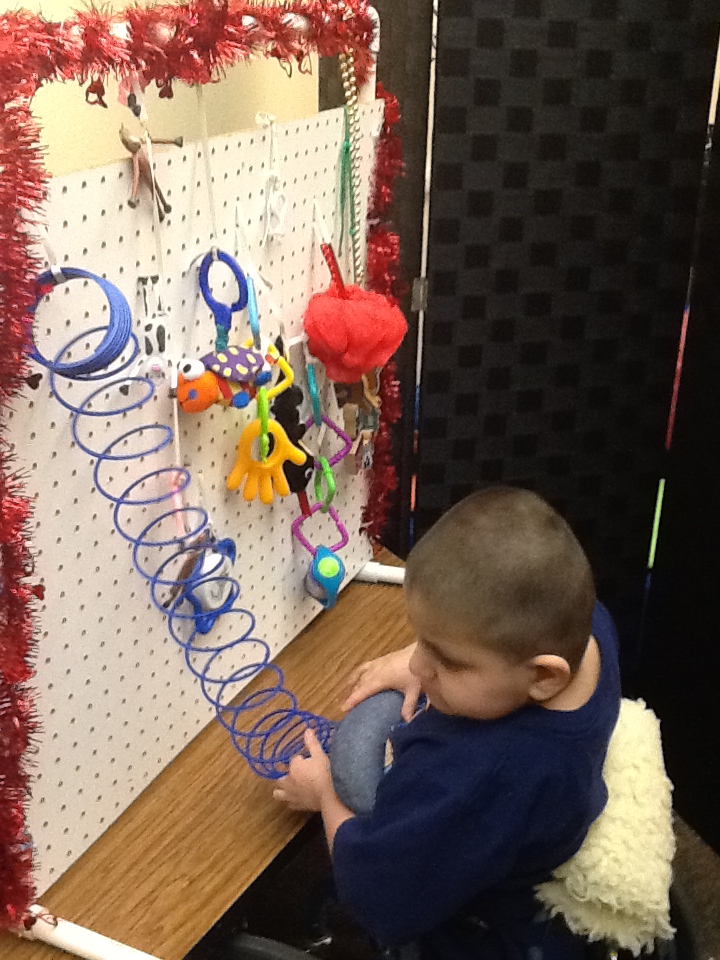
The Activity Board is a simple design that enables students
who are visually impaired and have additional impairments to explore a variety of textures and toys. The Activity Board is constructed from pegboard, a PVC frame, and items are attached to
the board with fabric elastic. The purpose of the Activity Board is to enable the students to explore the objects visually or tactually without moving away from their range of access.
The board may be positioned on the floor to allow the students access to it through side lying or low sitting positions, or it may be attached to a higher surface which they may access
during standing activities. The board is easily adapted to meet the needs of individual students by attaching items of a particular color,
texture, or sound, in addition to the placement of items within the student’s visual field. .
O&M Inventory
O&M Inventory
Handle With Care

Handle With Care Information
Trátelo Con Cuidado información - Español
Handle with Care trifold
Babies Count
Babies Count is a national registry of young children aged birth to 36 months of age with visual impairments that works in conjunction with public and private agencies to collect standardized epidemiological and demographic data regarding children, their visual conditions, and the systems created to support them and their families.
The New Mexico School for the Blind and Visually Impaired has accepted the role of developing, launching, and housing the database for Babies Count, however, the effectiveness and reliability of Babies Count depends on each of us. The basic structure is as follows:
Each state will assign a lead agency in the database and then enroll the individual agencies within the state that serve B-3 children who are blind/visually impaired.
Each individual agency will create its own system for completion of surveys and training its staff.
And finally, each agency, including service providers, must become committed to collecting this data for each child on his or her caseload, both at entry and at exit to the program.
Each state’s lead agency as well as each individual agency will have access to its own data for analysis and planning purposes.
For More Information visit: babiescount.org
Other Resources
Birth To Three / Eyeglass Fund Application
ONH Survey Packet: The Vision Center, Children's Hospital of Los Angeles:
Parent Cover-Letter (PDF)
Service Provider Cover-Letter (PDF)
Survey - Sept. 2013 (PDF)
Optic Nerve Hypoplasia: Review Article (PDF)
External Agencies - Resources for the Blind and Vision Impaired
Pediatrics Journal: ONH Proposed Study - Article 1 (PDF)
Pediatrics Journal: ONH Proposed Study - Article 2 (PDF)
Autism in Children with ONH and other VI - Article(PDF)
Autism and ONH, Dr. M. Borchert - WREIC Conference 2015 Presentation (Part 1)
Autism and ONH, Dr. M. Borchert - WREIC Conference 2015 Presentation (Part 2)
Student Instruction Pages
Mr. Killebrew's Instruction Pages
Staff and Student Blogs
Back to Home

